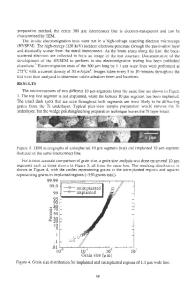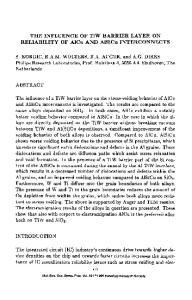The Influence of Stress-Induced Voiding on the Electromigration Behavior of AlCu Interconnects
- PDF / 421,943 Bytes
- 6 Pages / 612 x 792 pts (letter) Page_size
- 19 Downloads / 406 Views
The Influence of Stress-Induced Voiding on the Electromigration Behavior of AlCu Interconnects A.E. Zitzelsberger and A.H. Fischer Infineon Technologies Reliability Methodology Otto Hahn Ring 6 D-81739 Munich, Germany ABSTRACT The influence of stress-induced voiding on the electromigration (EM) behavior has been investigated on narrow via-line structures. For this purpose the EM performance of metal lines containing stress-induced voids already before the electrical operation has been compared with samples without stress-induced voids. We found, that pre-existing stress voids in the metal lines do not affect the activation energy Ea and lead only to a small decrease of the EM median time to failure, but cause a relevant reduction of the current density exponent down to n = 1. As a consequence, a tremendous decrease of the electromigration limited life time is obtained. INTRODUCTION Stress-induced voiding in metal interconnects is an important aspect in reliability methodology. The phenomenon is driven by the relaxation of thermally induced and intrinsic stress. The thermally induced tensile stress is obtained in the interconnect due to the thermal mismatch between metal and surrounding SiO2-dielectric during cooldown from high deposition temperatures. As a result, stress-induced voids are observed in the metal line before electrical operation. In our particular case the occurance of these voids was found to be related to a high density plasma process (HDP) during the deposition of the intrametal dielectric. The stress voids could completely be suppressed by introducing an anneal process after the metal patterning combined with a reduced HDP-temperature. Other methods to avoid initial voids are described in [1,2]. In most cases the discussion of stressmigration related reliability risks is limited to the resistance increase which correlates to the growth of stress-induced voids and affects the functionality of the circuit. This primary risk can be assessed by providing a model which allows, similar to Black's equation for electromigration, the transformation of the failure distribution from highly accelerated to operation conditions [3,4]. However, the influence of stress-induced voids on the electromigration performance has to be considered as a secondary risk. As proposed by Lloyd [5,6], the current density exponent n in Black´s equation will be close to n = 1 if the electromigration failure in the metal line is due to the growth of pre-existing voids. Systematic investigations supporting this behavior will be presented in this paper.
D8.9.1
EXPERIMENTAL Electromigration tests have been performed on metal layer M1 of a 3 level AlCu-metallization. Two different types of via-line teststructures were investigated, one with a short 30µm line and one with a long 500µm line (Fig.1). Both teststructures were stressed with an electron flow direction from metal layer M0 (W) into metal layer M1 (AlCu). In order to determine the activation energy Ea and current density exponent n the EM tests were performed at various tempe
Data Loading...











